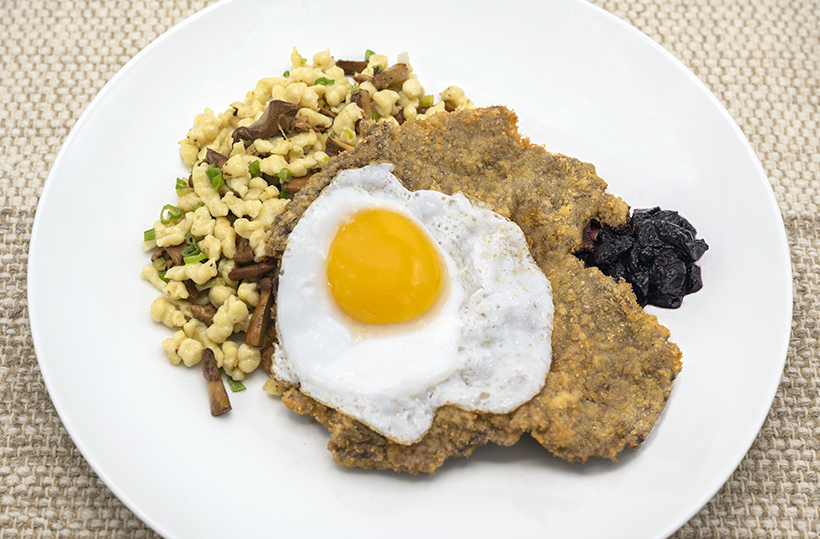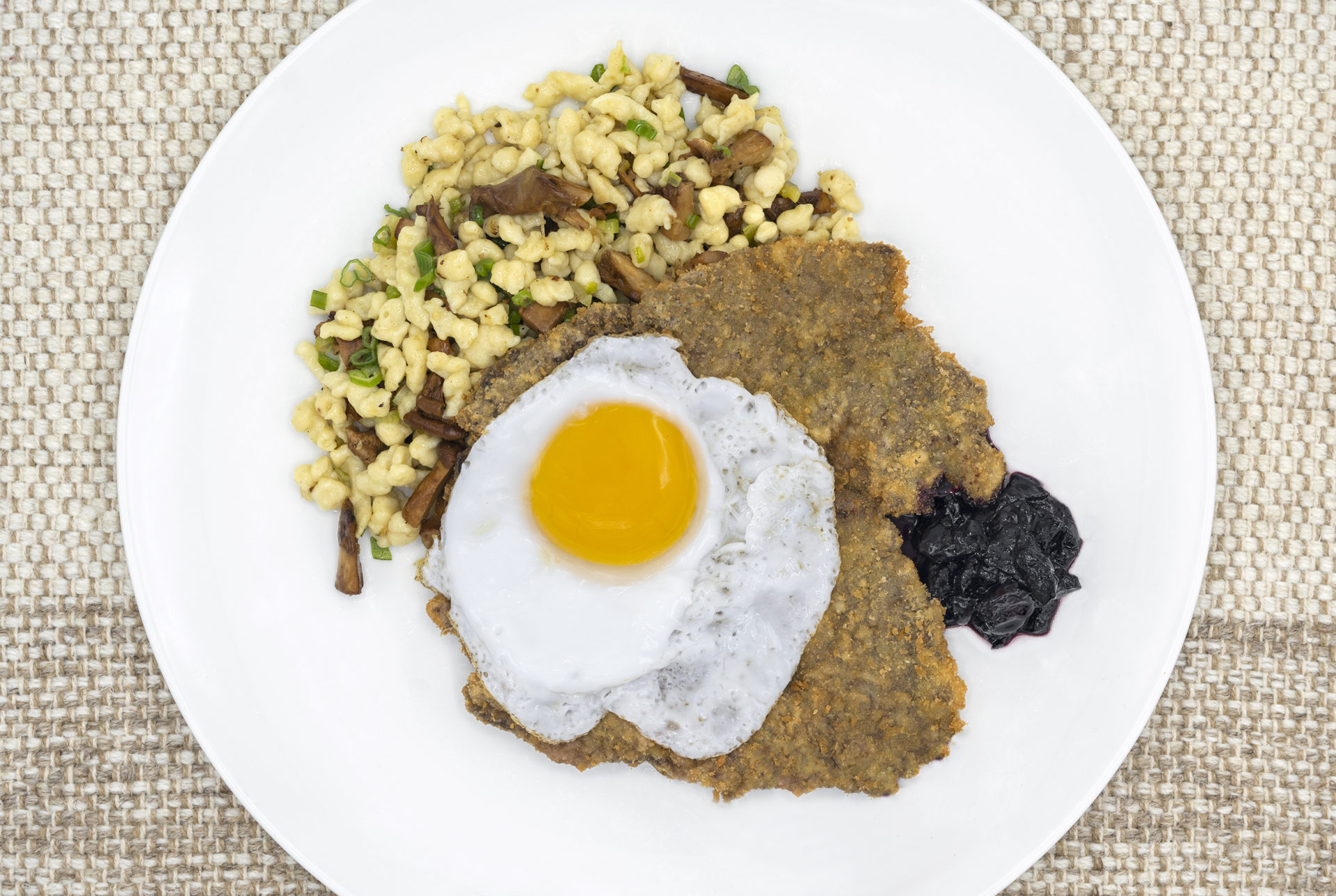After the kielbasa, here’s another wild goose recipe to reserve for slightly more tender birds: a classic schnitzel with spaetzle. It won’t be the first schnitzel on this blog; over ten years ago, I published both a wild turkey schnitzel with Finger Lakes Riesling sauerkraut and red currant jelly, and a partridge schnitzel and meatball, red pepper sauce, corn and zucchini. But never have I told the story of this humble piece of breaded meat. Or, well, the “story”…
The German word schnitzel is a diminutive of schnitz, meaning “slice” (do you remember the cremeschnitte?). Its most popular variation, the Wiener schnitzel, consists of a piece of pounded veal, preferably from the hip, breaded, fried in butter, and traditionally garnished with a wedge of lemon and some potato salad.
However, breaded schnitzel is found only relatively late in Viennese cookbooks, the first surviving occurrence being in Ignanz Gartler’s Nutzliches Koch-Buch (Useful Cookbook) from 1740, where it appears as recipe number 232. Here with the help of Google Translate:
Veal schnitzel with Parmesan cheese and bread slices
Take a good leg, cut a small slice from it, pound it very wide, season with salt, sprinkle with flour and bake in lard until golden brown. Prepare small baked bread slices, arrange them in a dish with the baked schnitzel and grated Parmesan cheese in layers, sprinkle with good spices, pour a good chicken soup on it, and then let it boil well, so that it becomes very tender. When it’s time, put it on the counter.
Though there are about as many takes on the subject as there are cookbook authors, one prevailing theory for the Viennese specialty’s origins is that it doesn’t hail from a Germanic country at all, but is in fact a cousin of the Italian cotoletta alla milanese.
By some accounts, breaded veal was consumed in Italy much earlier than the 18th century. The name of Apicius is sometimes mentioned, though I haven’t found any similar recipe in my edition of his ancient Roman cookbook. There’s evidence that in 1134, a banquet served in honor of the canon of the Basilica of Sant’Ambrogio in Milan included breaded and fried veal loin chops, or at least “veal loin with bread” (still a pretty vague description), according to a report by the abbot.
Fast forward to the end of the 15th century, again in northern Italy. Among the Venetian aristocrats of the time, it was fashionable to decorate dishes with gold leaf, officially for dubious medical reasons but really just to show off their own wealth. The Great Council of Venice eventually banned the custom, and some chefs supposedly had the idea of breading the meat in an effort to reproduce the sought-after golden color. Within a few decades, the technique spread to the whole of Central Europe. In particular, the Viennese became fond of this new preparation method and started breading every piece of meat under the sun. Of course, the fact that it took another three centuries for schnitzel to make it into an Austrian cookbook casts a certain amount doubt about this uncorroborated tale…
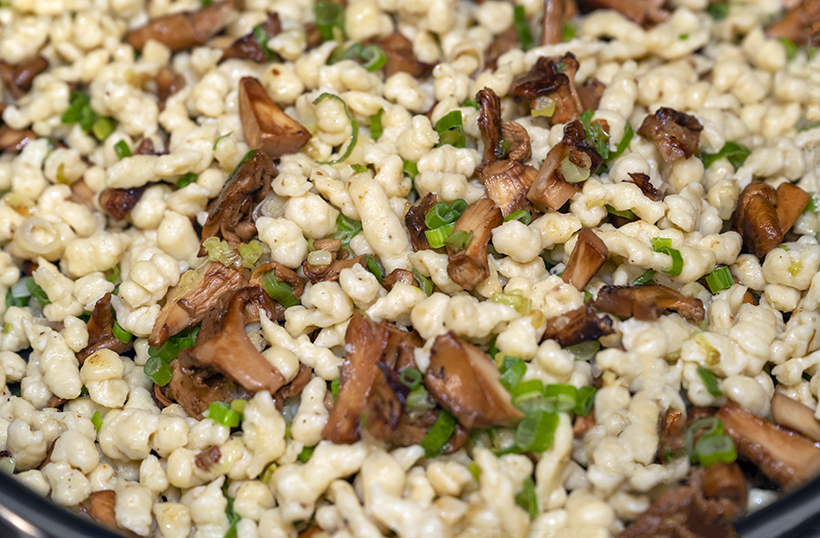
Regardless of how exactly it got there, schnitzel remains very popular in Central Europe to this day. In Czech Republic, řízek is made of pork, chicken, or veal, served with boiled or mashed potatoes or potato salad, when it’s not consumed between two slices of bread as a sandwich for a lunch on the go. In Slovakia, rezeň or šniceľ is often prepared with pork or chicken, garnished with rice or anything potato – fried potatoes, boiled potatoes, mashed potatoes, fries, potato salad… In Hungary, bécsi szelet (Viennese slice), borjú bécsi (Viennese veal) or rántott hús (breaded meat) is a common meal in homes and restaurants, often prepared on Sundays or for festivities with spaetzle, fries, mashed potatoes, or rice. And the popularity of the schnitzel doesn’t stop there: you’ll find variations in Croatia, Serbia, Bulgaria, Poland, Russia, Ukraine, Romania…
Sorry, but this still isn’t the time I’ll be serving my schnitzel with potato! Instead, I’m taking a Hungarian approach and making spaetzle, with the twist of adding celery root to the dough, and sautéing the pasta with chanterelles and scallions. A few sour cherries in a port wine reduction provide a nod to a classic goose pairing. Finally, you don’t need to get a hunting license to enjoy this dish: it works just as well with a farmed goose breast, a boneless pork chop, or a veal cutlet.
Goose Schnitzel and Celery Root Spaetzle
Yields 4 servings
Total preparation: 2 hours 45 minutes
Active preparation: 1 hour 45 minutes
Sour cherries in port
160 g pitted sour cherries
560 g ruby port wine
- Place the sour cherries and port in a small saucepan. Reduce over medium heat until the cherries are coated in sauce, for about 30 minutes, lowering the heat for the last several minutes to avoid burning the reduction. Let cool and reserve.
- The cherries can be kept in a plastic container in the refrigerator for up to a week.
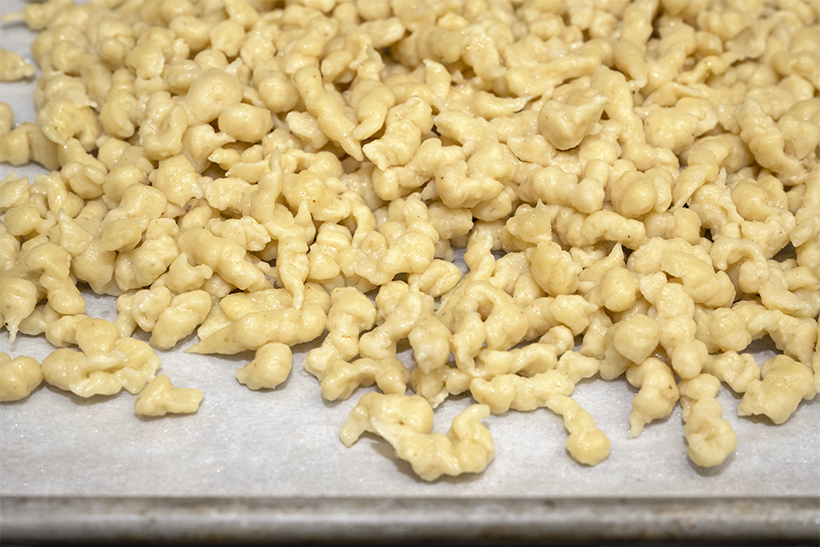
Celery root spaetzle
300 g peeled celery root
30 g duck fat, melted
90 g (about 1 1/2) eggs
15 g (about 1) egg yolk
150 g bread flour
3 g baking powder
6 g salt (plus some for the spaetzle water)
0.15 g ground black pepper
0.15 g ground nutmeg
- Cut the celery root into slices 2-3 cm thick, brush both sides with about half of the duck fat, and place on a baking sheet lined with parchment paper. Bake in a 200 C / 400 F oven until golden brown, for about 30 minutes, flipping at mid-time. Let cool on the tray.
- Transfer the celery root to a blender, add the eggs and egg yolk, and blend on medium speed for 1 minute.
- Pour the mixture into a stand mixer fitted with the paddle attachment. Add the flour, baking powder, salt, pepper, and nutmeg. Mix on medium speed for 3 minutes, then on high speed for another 2 minutes. Cover and let rest for 30 minutes.
- Bring a pot of salted water to a boil. Proceeding in small batches, scrape the dough through a spaetzle maker into the boiling water (see photo below). Cook until tender, about 1 minute, then use a skimmer to drain onto a sheet pan lined with parchment paper. Toss the spaetzle with some of the remaining duck fat, and spread evenly across the sheet pan.
- When done, cover with plastic wrap, and reserve.
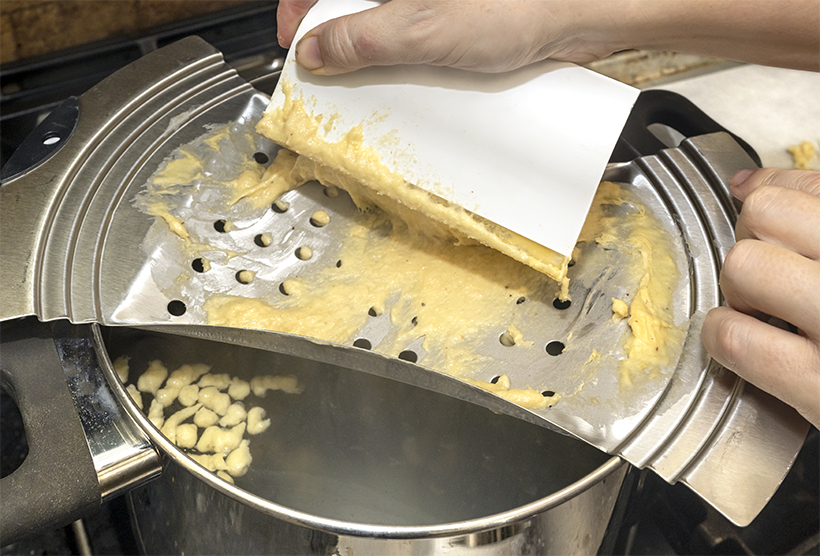
Assembly
400 g goose breast without any silverskin, cut into 4 pieces
150 g AP flour
120 g (about 2 1/2) eggs, beaten
250 g breadcrumbs
salt
canola oil, for deep-frying
180 g cleaned chanterelles, cut into 2 cm x 1 cm pieces
30 g butter
65 g scallions whites, thinly sliced
black pepper, ground
celery root spaetzle
20 g scallion greens, thinly sliced
4 duck eggs
sour cherries in port, room temperature
- Butterfly each piece of goose breast, place between two sheets of plastic wrap, and flatten to a disc of 16-17 cm diameter using a meat pounder. Reserve.
- Place the flour, eggs, and breadcrumbs separately onto three large plates or trays (wider than the pounded meat), seasoning each one with salt.
- Fill a large pot (wider than the meat) with 5-6 cm of canola oil, and heat to 190 C / 375 F (you can use a deep-fryer if you prefer). Keep the oil around this temperature with the heat on low.
- In a pan over medium heat, sauté the chanterelles in half of the butter until soft. Add the scallion whites and remaining butter, season with salt and pepper, then cook for a couple minutes, stirring constantly. Mix in the spaetzle and scallion greens, rectify the seasoning, cook for another minute, and reserve.
- Processing in batches, coat each goose schnitzel successively with flour, egg, and breadcrumbs. Carefully lower into the oil and cook until just colored, to ensure the meat remains pink inside. Use a spider to transfer to a plate lined with paper towels, and reserve.
- In a non-stick pan over medium heat, fry the duck eggs in a little bit of canola oil until the white is just set. Season with salt and reserve.
- On each serving plate, place some spaetzle on one side, and on the other, place a goose schnitzel topped with a duck egg. Garnish with a few sour cherries in port, and serve.
